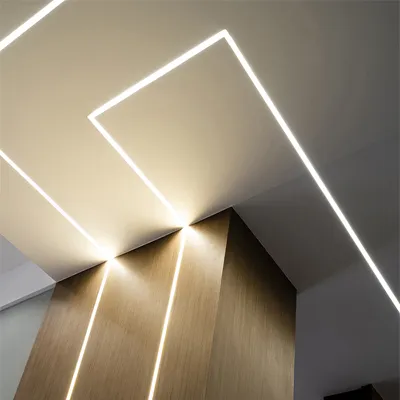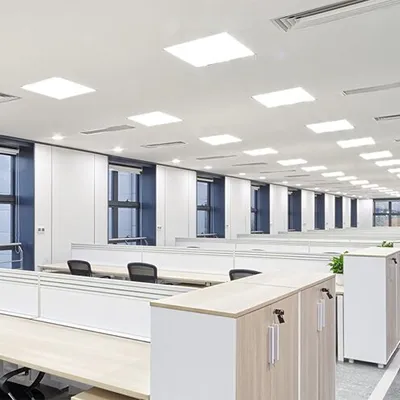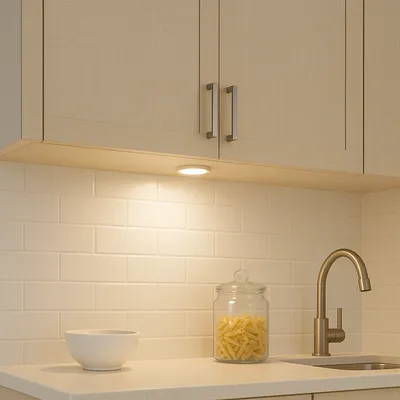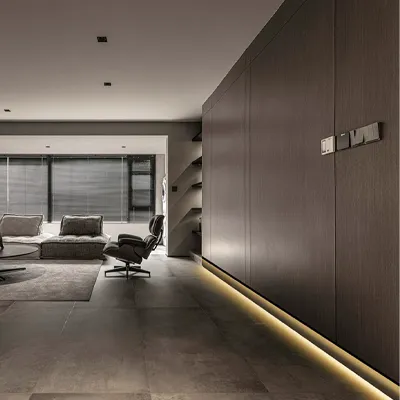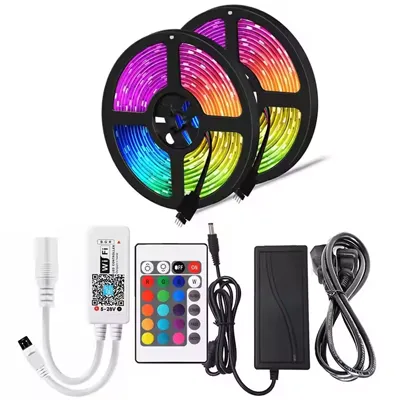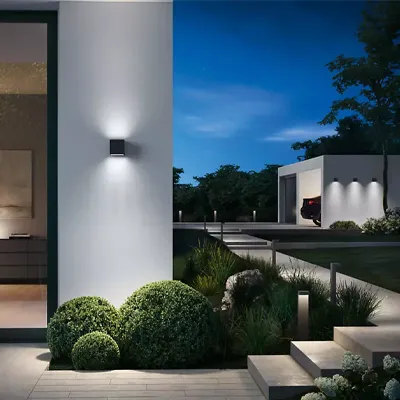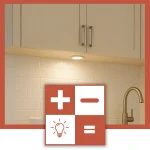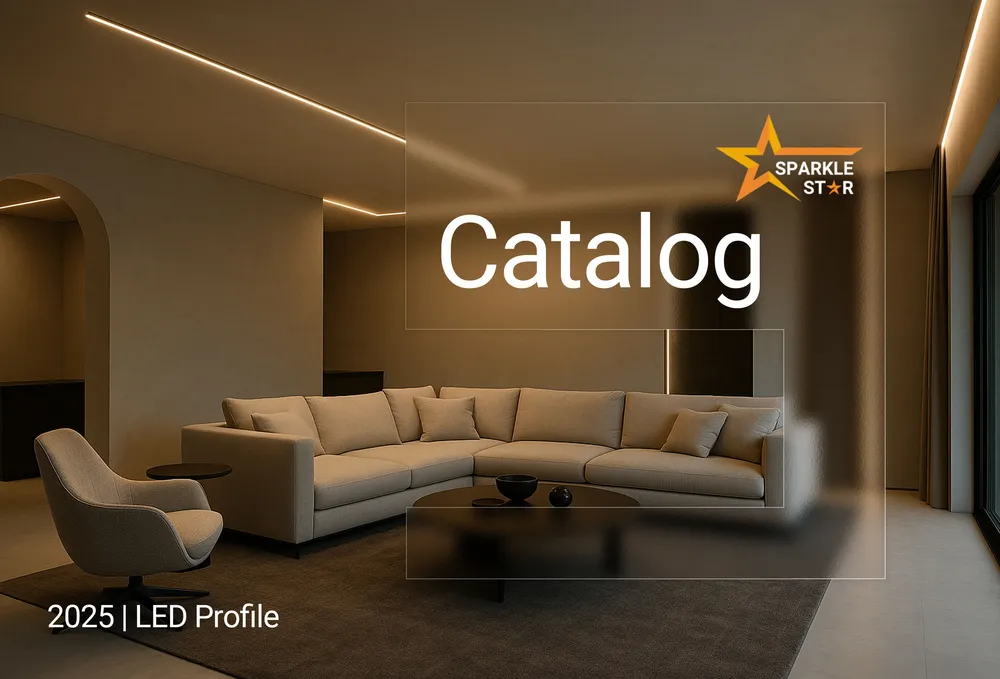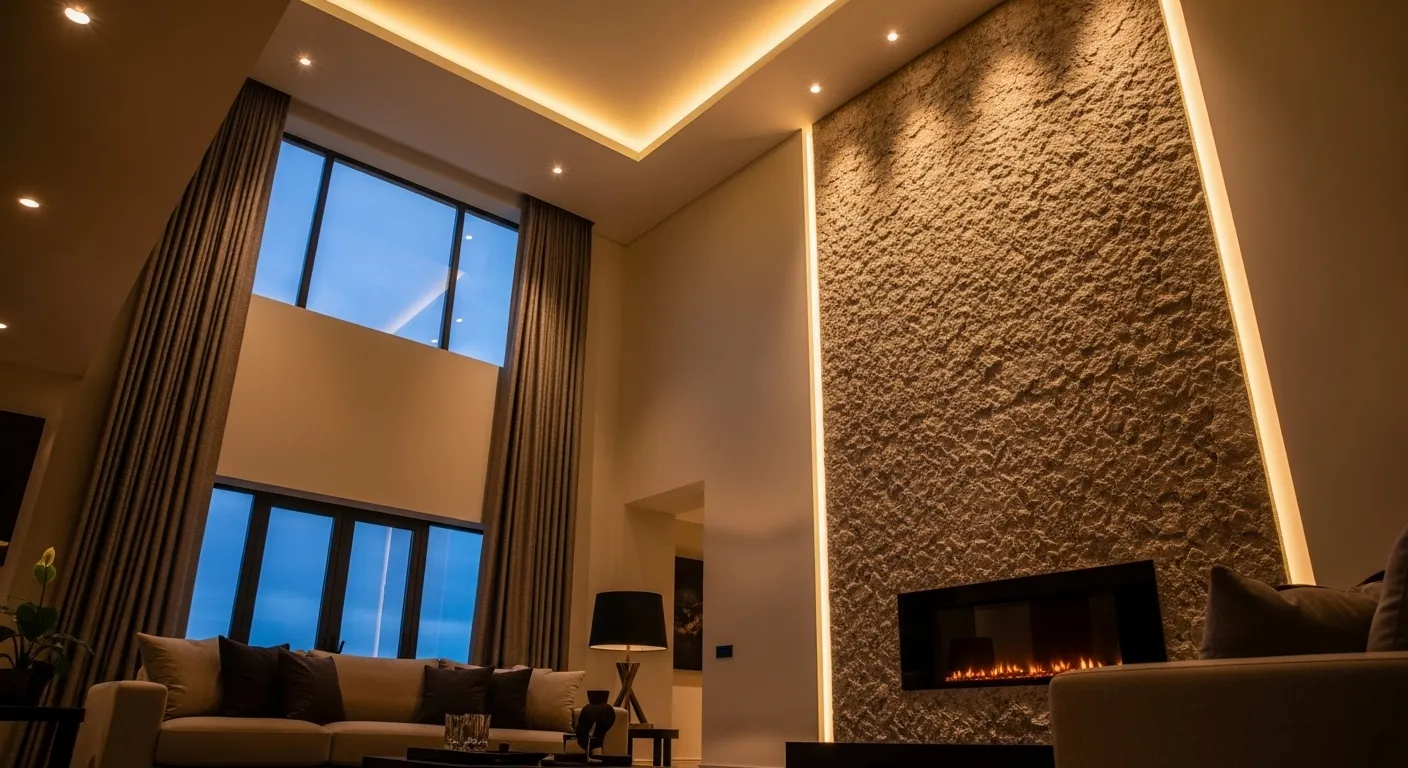
Light Is More Than Brightness
The character of a well-lit space is rarely determined by brightness alone. A more fundamental quality, its direction, sculpts everything from the room's atmosphere to its perceived size. This principle is at the heart of the downlight vs uplight decision. It is not a simple choice between fixtures, but a deliberate selection between two distinct design outcomes. Mastering this difference is what separates a merely illuminated room from a space that is intentionally and beautifully designed. This guide provides the practical knowledge to make that choice with confidence.
Downlighting for Function and Focus
Downlighting is the foundation of nearly every functional lighting plan. Its principle is simple and aligns with our most basic experience of light: it comes from above. This top-down illumination provides clarity, defines spaces, and allows us to perform tasks effectively and safely. It is the workhorse of the lighting world, responsible for the primary layers of ambient and task illumination. A well-executed downlighting scheme is not about scattering lights across a ceiling; it is a calculated plan to deliver the right amount of light, precisely where it is needed.
Kitchens and Workspaces
The modern kitchen is a multi-functional space, serving as a prep area, a social hub, and a workspace. This demands a lighting plan that is equally versatile. The most common lighting failure in a kitchen is relying solely on a single, central ceiling fixture. This configuration forces you to work in your own shadow, as the light source is almost always behind you when you stand at a counter.
A professional approach solves this with two distinct layers of downlighting:
- General Illumination: A grid of classic Downlights recessed into the ceiling provides the ambient light for the entire room. The goal is to create overlapping cones of light that produce an even, comfortable brightness. Spacing is critical; fixtures placed too far apart will create dark spots, while those too close can feel harsh and clinical.
- Task Illumination: This is where precision matters most. Under Cabinet Lighting is not a luxury; it is an essential tool. By mounting a linear fixture directly beneath the upper cabinets, the light source is placed in front of you, flooding the countertop with a bright, shadow-free work surface.
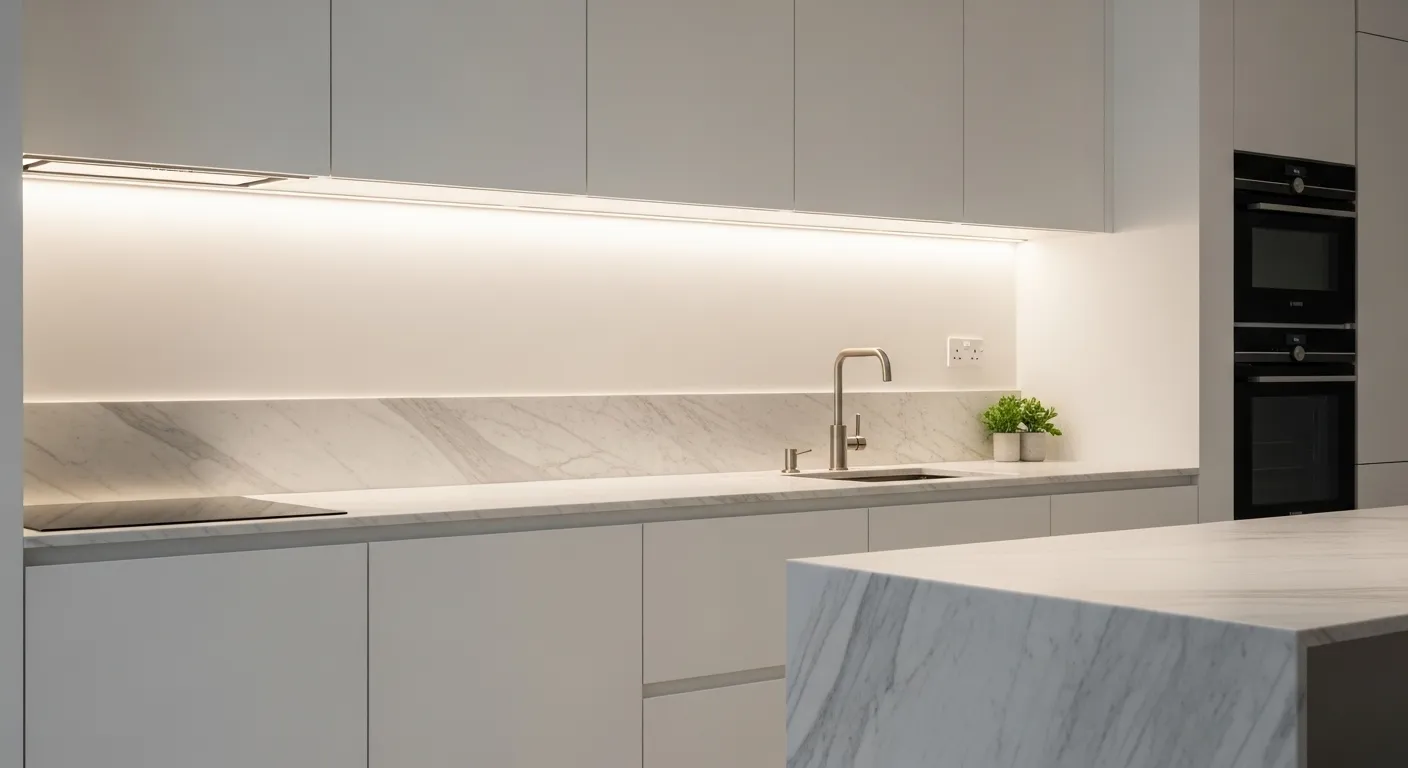
For these applications, technical specifications are not just numbers, they directly impact the quality of the space. Consider the Color Rendering Index (CRI).
Expert Information: The Importance of High CRI in Kitchens
The Color Rendering Index (CRI) measures a light source's ability to reveal the true colors of objects, on a scale of 0 to 100. For most areas, a CRI of 80+ is acceptable. In a kitchen, however, a CRI of 90 or higher is the professional standard.
- With a low CRI, fresh red meat can look dull and brownish, vibrant green vegetables may appear washed out, and it becomes difficult to judge the doneness of food.
- With a high CRI (90+), colors are rendered faithfully, making food look more appealing and allowing for a more accurate and enjoyable cooking experience.
Hallways and Stairs
In transitional spaces like hallways and staircases, the primary function of lighting is safety and navigation. Downlighting is the ideal solution. Recessed Downlights provide clear, unobstructed illumination without cluttering the ceiling or creating physical obstacles.
The key to success here is creating a visual rhythm. A properly spaced series of downlights guides the eye and the feet, ensuring each step is visible. A common mistake is using too few lights with very narrow beams, which results in pools of bright light surrounded by unsettling darkness. A wider beam angle (e.g., 60 degrees or more) from each fixture helps to smooth out the illumination, creating a continuous and reassuring path of light.
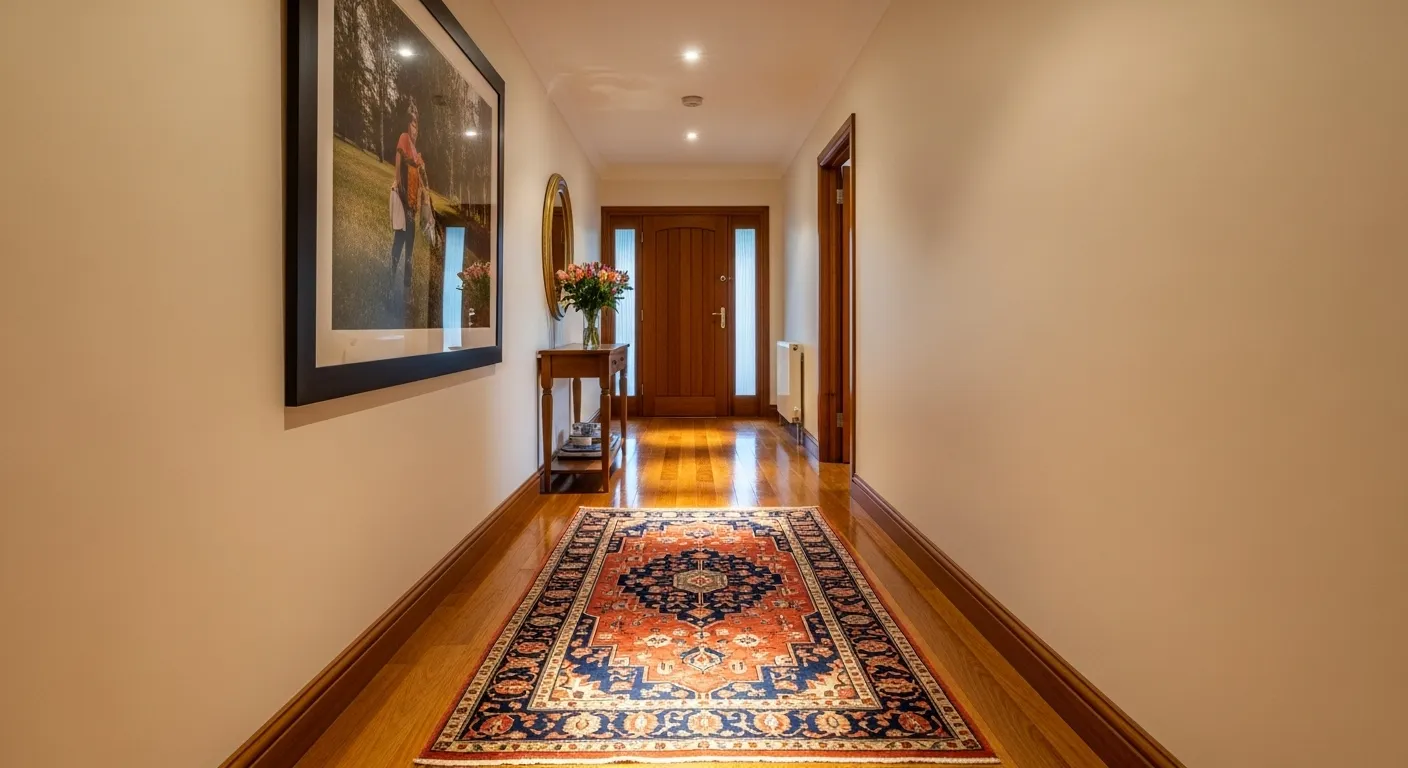
Flexible Accent Lighting
Downlighting is not limited to purely functional roles. It can also serve as a powerful tool for accentuation. While a fixed recessed downlight can highlight a feature, its permanence is a limitation. If you rearrange furniture or change artwork, the light cannot adapt.
This is where Track Lighting demonstrates its value. It is the most adaptable downlighting system available. The track itself is a power source, allowing multiple light heads to be attached, moved, and aimed independently. This gives you the freedom to:
- Use narrow-beam spotlights to precisely highlight a painting.
- Use wider-beam floodlights for a general wash of light on a bookshelf.
- Change the entire lighting scheme when you redesign the room, without needing an electrician.
Track lighting transforms a static ceiling into a flexible platform for creative and precise downlighting.
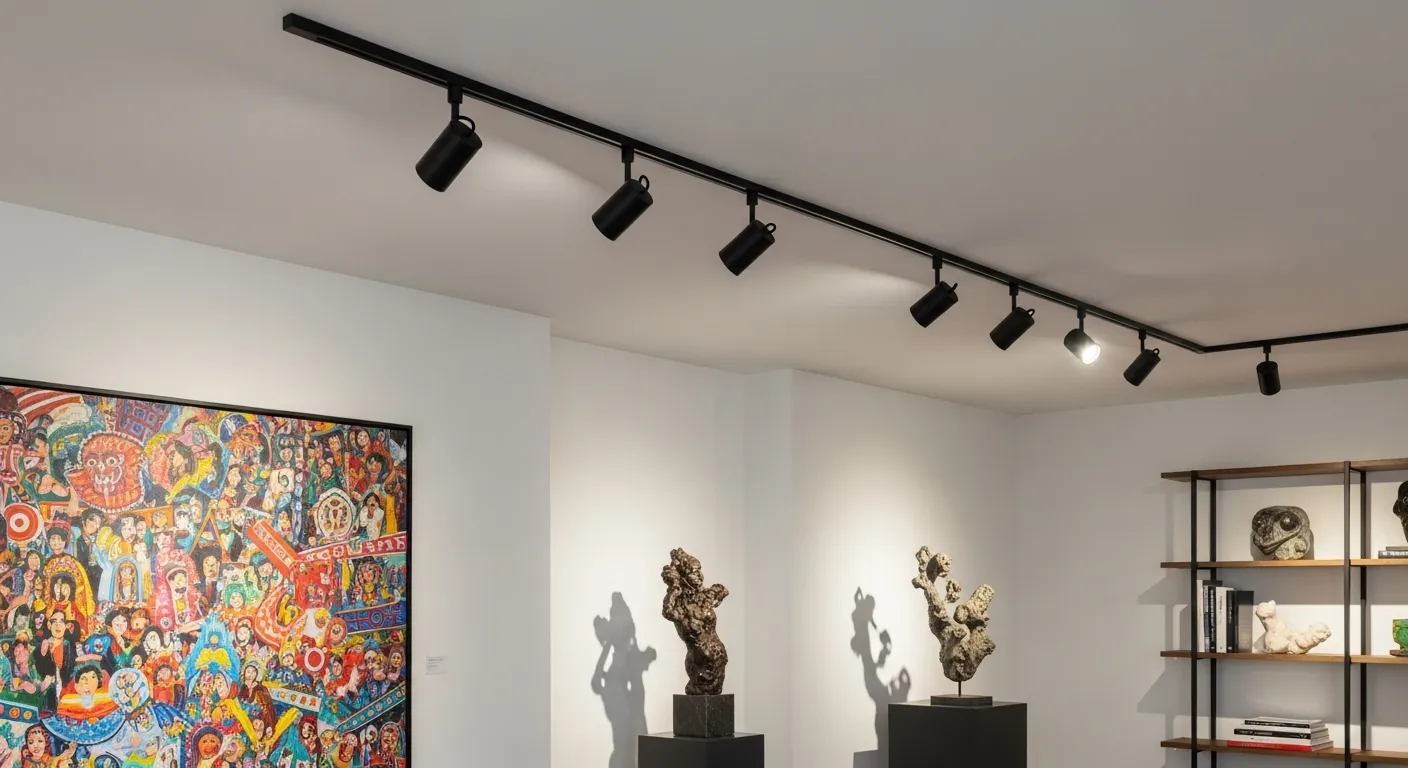
Uplighting for Atmosphere and Drama
If downlighting is the prose of lighting design, uplighting is the poetry. It works by subverting our natural expectation of light from above. By casting illumination upwards, uplighting introduces an element of the unexpected, creating atmosphere, drama, and a sense of luxury. It is a technique used to shape perception, making spaces feel larger, richer, and more architecturally significant. While its primary role is for accent and ambient effects, its impact on the feel of a space is profound.
Creating a Sense of Height
One of the most powerful applications of uplighting is its ability to visually expand a room. Spaces with standard or low ceilings, especially when lit only with downlights, can suffer from what designers call the "cave effect": a brightly lit floor with a dark, heavy ceiling that feels oppressive.
Uplighting provides the definitive solution. By directing light onto the ceiling, that surface is brightened and appears to recede, creating an illusion of greater height and airiness. The most elegant way to achieve this is with indirect lighting, where the source itself is hidden from view.
The professional tool for this is Linear Light concealed within an architectural feature like a ceiling cove, a soffit, or placed atop tall cabinetry. The continuous line of light provides a seamless, soft glow that fills the room with comfortable, glare-free ambient light. The quality of the aluminum profile used in these systems is crucial; it acts as a heat sink, drawing heat away from the LEDs to ensure a long and stable operational life.
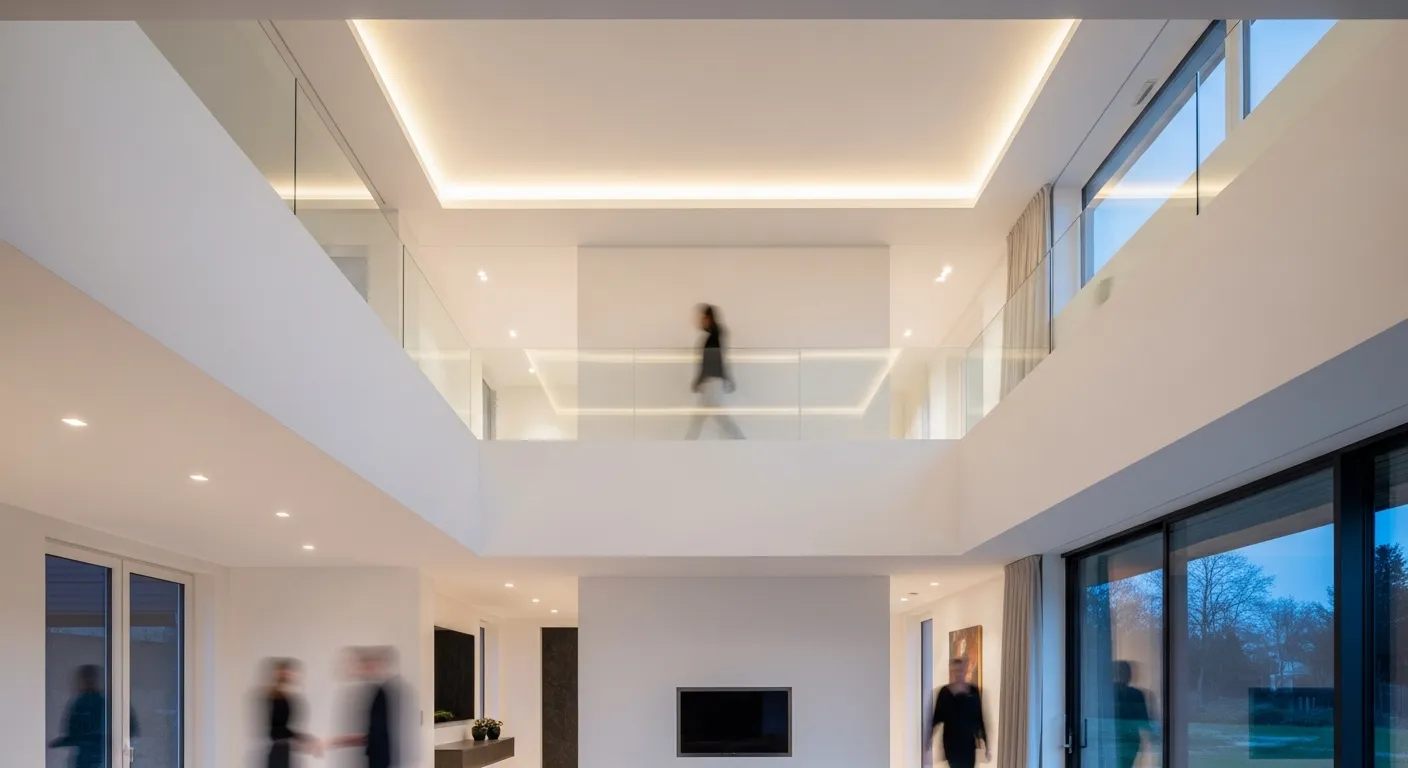
Showcasing Texture and Form
Uplighting is unparalleled for revealing the inherent beauty of materials and architectural forms. A flatly lit wall of textured brick or stone can appear dull and lifeless. The same wall, when grazed by uplighting, is transformed into a dramatic feature.
This technique, known as "grazing," involves placing a light fixture very close to the base of a vertical surface and aiming it straight up. The tight beam of light catches the outer edges of the texture, casting long, sharp shadows that reveal the material's depth and character. This is highly effective for:
- Stone or brick feature walls
- Architectural columns
- Corrugated metal panels
- Ornate moldings
A narrow beam angle, typically less than 25 degrees, is essential for a successful grazing effect. A wider beam would wash the surface with light, erasing the very shadows that create the drama.
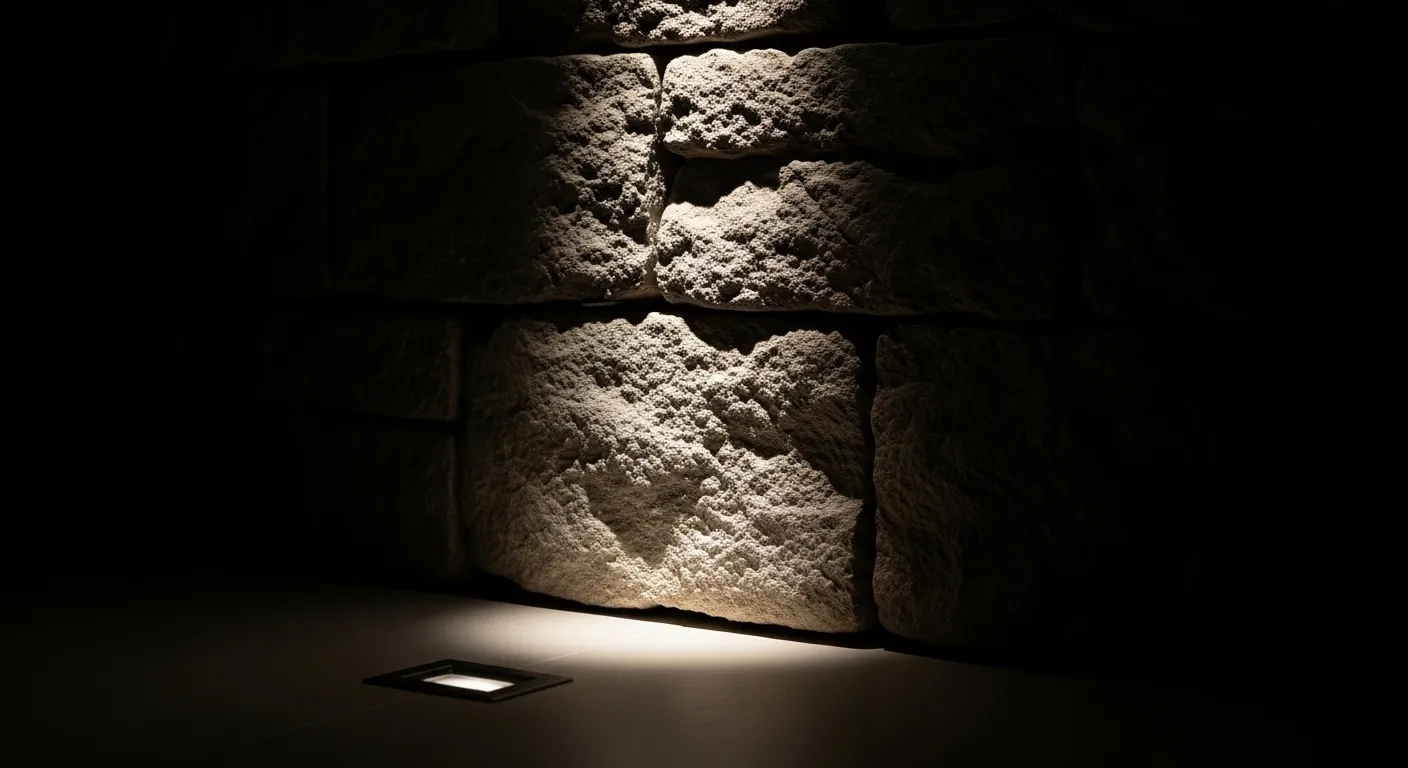
Defining Outdoor Spaces
After sunset, a property's landscape can recede into an undefined darkness. Uplighting is the key to extending the living space beyond the walls of the house and creating a stunning, high-end curb appeal.
Rather than flooding the entire yard with light, a selective approach yields far more dramatic results. Strategic uplighting on key features "paints" a picture in the darkness, adding depth and intrigue. Common applications include:
- Tree Illumination: Placing one or two spotlights at the base of a mature tree highlights its trunk structure and illuminates the underside of its canopy, turning it into a living sculpture.
- Facade Lighting: Uplighting the columns of a porch, the space between windows, or the full height of a building's facade adds a sense of grandeur and prestige.
This not only enhances the property's beauty but also creates a sense of a larger, well-defined, and secure outdoor environment. For these applications, fixtures with a high Ingress Protection (IP) rating, such as IP65 or higher, are required to ensure they can withstand dust, rain, and other environmental conditions.
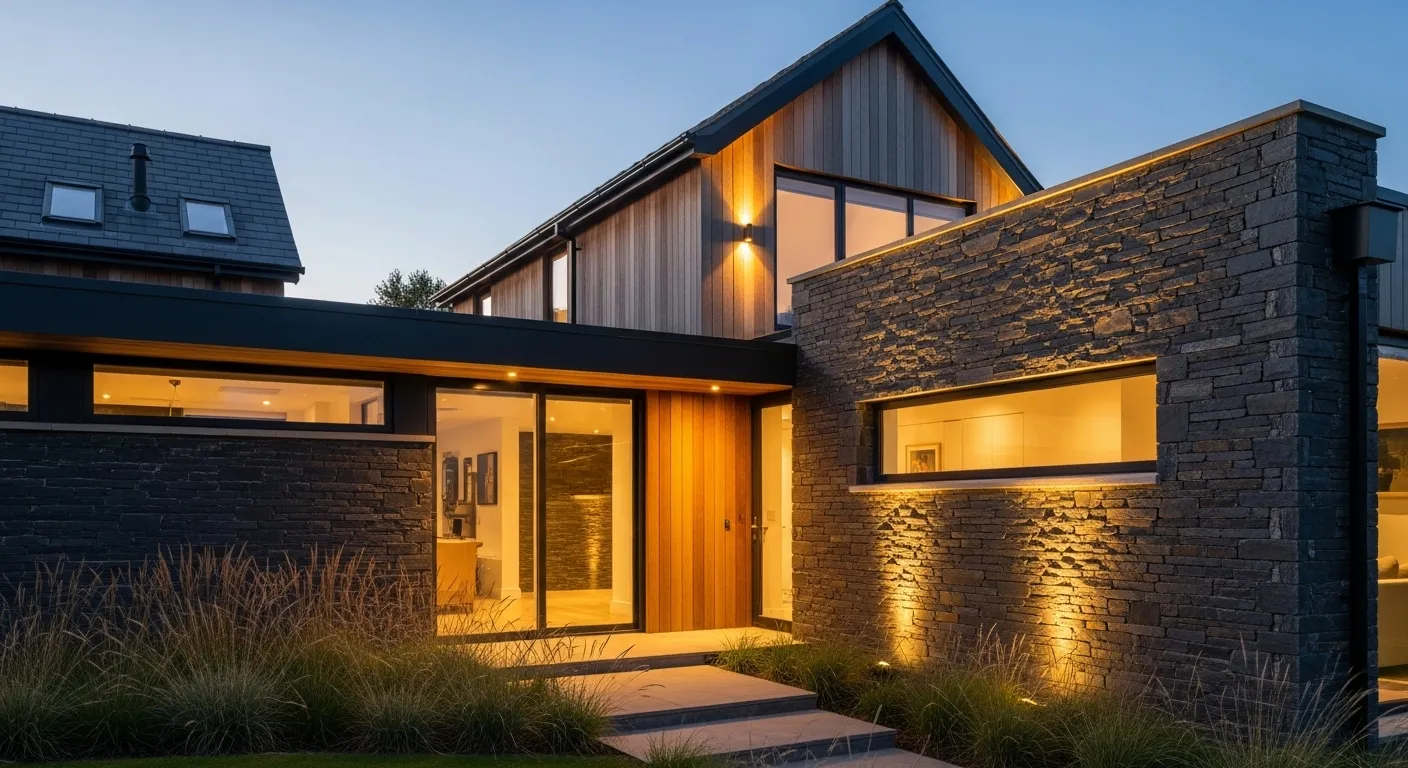
Downlight vs Uplight: Main Differences
The previous sections explored the specific applications of each lighting technique in detail. For a direct, at-a-glance comparison, the fundamental distinctions between downlighting and uplighting can be summarized in a clear framework. This allows for a quick understanding of their core purpose and the effect each one will have on a space.
Aspect | Downlighting | Uplighting |
|---|---|---|
Direction | Light points down | Light points up |
Primary Goal | Task, function, safety | Atmosphere, drama, accent |
Common Feel | Natural, clear, focused | Theatrical, spacious, soft |
Best For | Kitchens, offices, hallways | Living rooms, high ceilings, exteriors |
While this table highlights their opposing characteristics, it is crucial to view them not as competitors, but as complementary tools in a designer's toolkit. Very few sophisticated lighting schemes rely on one technique exclusively. The most successful and comfortable environments leverage the functional clarity of downlighting and combine it with the atmospheric depth of uplighting. Understanding their distinct roles is the first step toward using them together in a balanced, layered design.
Solving Common Lighting Problems
Even with a basic understanding of downlighting and uplighting, real-world projects can present challenges. Many common lighting complaints are not failures of the concept, but of the execution or the quality of the equipment. Addressing these issues head-on with actionable, expert advice is the key to moving from a flawed installation to a professional result.
1. Fix the "Cave Effect"
This is arguably the most frequent problem in residential lighting. The scenario is a room, often a living room or basement, that is filled with recessed downlights. The floor is brightly lit, but the ceiling and upper portions of the walls remain dark. This high contrast creates a gloomy, oppressive atmosphere that feels unwelcoming, much like being in a cave looking up at the sky.
The root cause is a one-dimensional lighting plan. All light is directed downwards, completely ignoring the vertical surfaces that define our perception of a space.
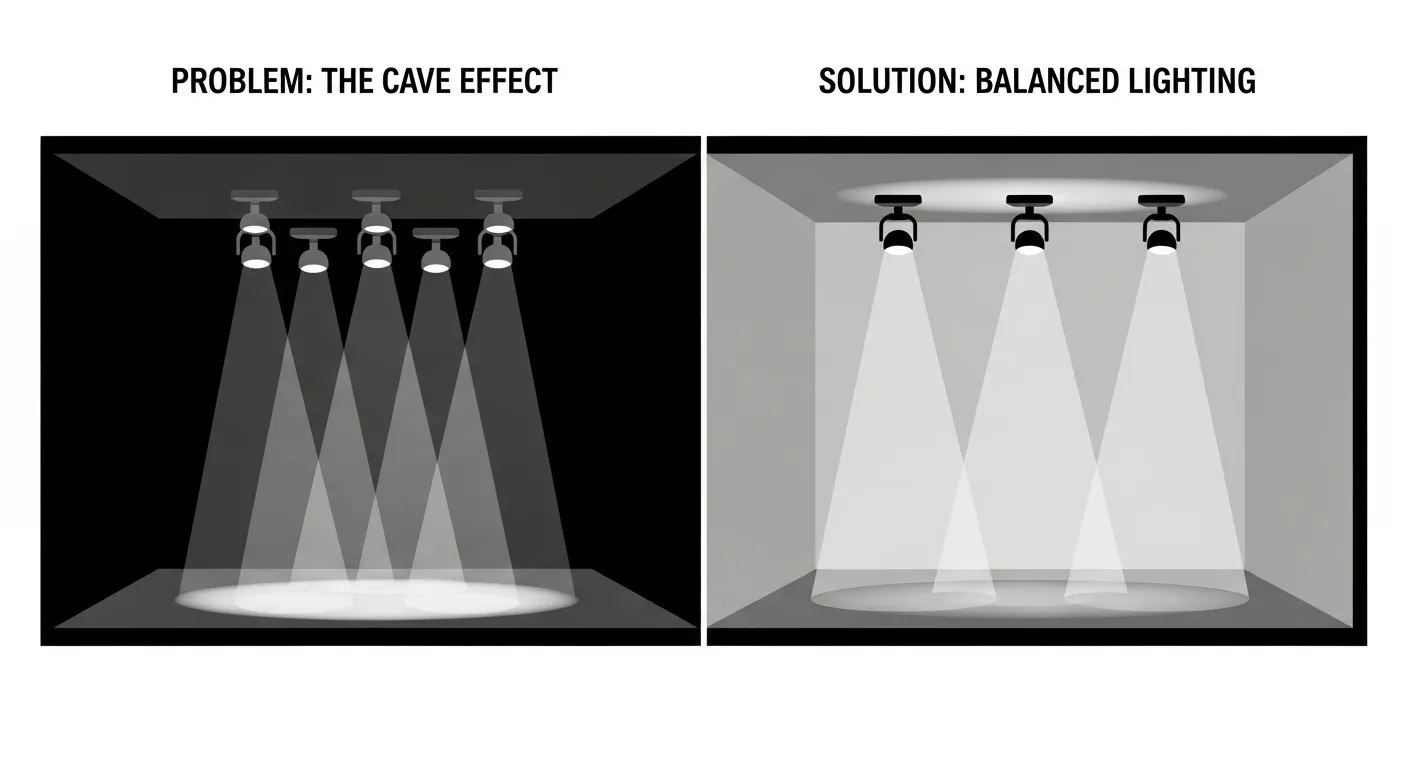
The Professional Solution: The solution is to introduce light to the upper half of the room, creating a more balanced and visually comfortable environment. This is achieved by layering light:
- Wall Washing: This technique involves using downlights or track lights aimed to spread a smooth, even layer of light across a wall. This immediately makes the room feel brighter and larger by illuminating its boundaries.
- Sconces and Accent Lights: Adding wall sconces provides points of light at eye level, breaking up the monotony of a dark wall. Aiming an accent light at a tall piece of furniture or a fireplace can have a similar effect.
- Indirect Uplighting: As discussed previously, using concealed linear lights in coves or on top of high cabinets to bounce light off the ceiling is the most elegant solution. It not only eliminates the cave effect but also provides a soft, glare-free ambient light for the entire space.
2. Avoid Uncomfortable Glare
Glare is any excessively bright light source that causes visual discomfort or reduces visibility. It can be direct, where you see the harsh light source itself, or reflected, where the light bounces off a shiny surface like a polished floor or glass tabletop.
- Uplighting Glare: A common mistake is placing an uplight fixture where the bulb or LED is directly visible from a normal viewing angle, such as from a seated position on a sofa. This creates an intensely distracting and uncomfortable point of light.
- Downlighting Glare: Many low-quality downlights have a shallow design where the light source sits nearly flush with the ceiling plane. This allows light to spill out at high angles, shining directly into a person's eyes as they walk through the room.
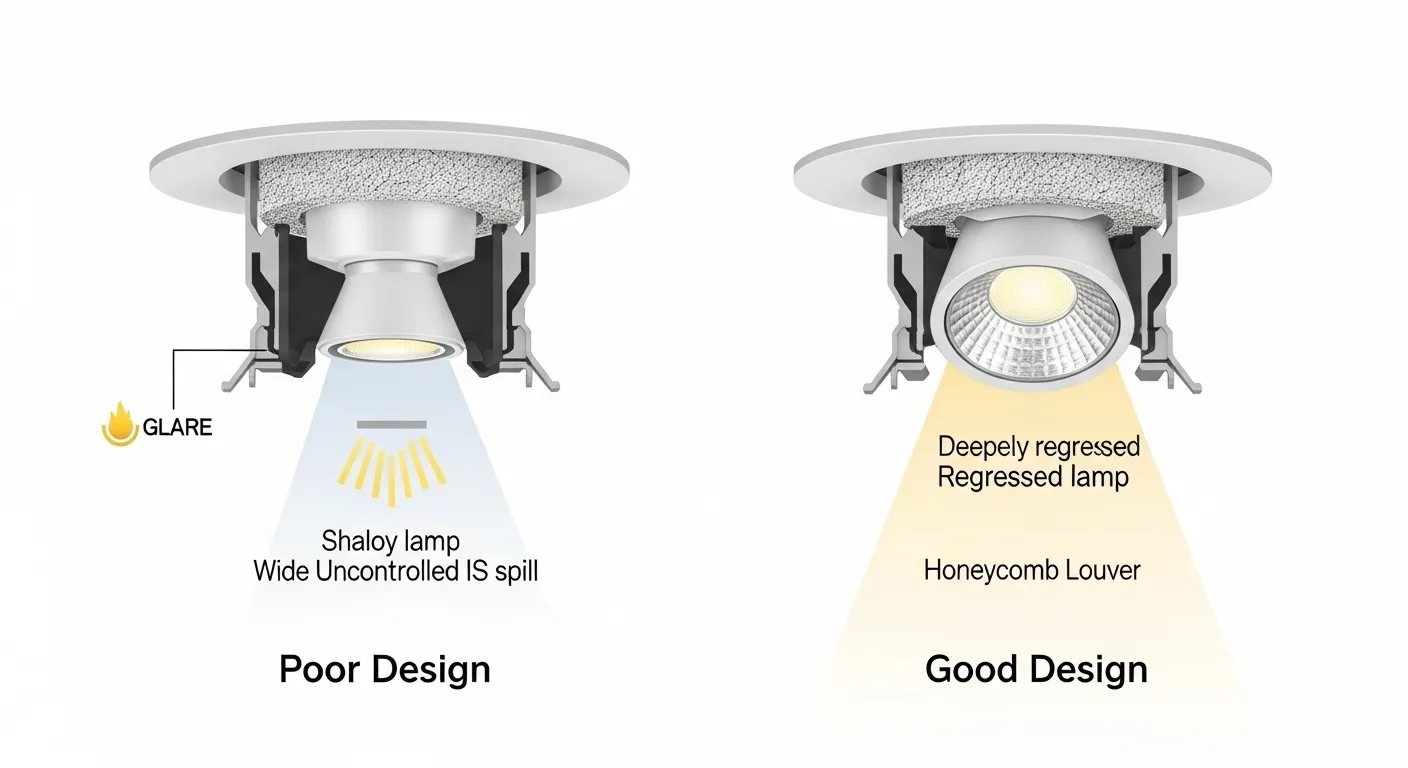
The Professional Solution: Glare control is a hallmark of quality fixture design and thoughtful placement.
- Choose High-Quality Fixtures: Look for products designed to manage glare. For downlights, this means a regressed design, where the light source is set deep within the fixture housing. For both up- and downlights, accessories like glare shields, hoods, or honeycomb louvers are critical. These attachments physically block the light from being viewed at uncomfortable angles, ensuring you see the intended lighting effect, not the raw source.
- Strategic Placement: Conceal the fixture. When uplighting from the floor, hide the light source behind a plant or piece of furniture. Aim lights carefully to hit the intended target without creating stray beams that cause issues.
3. Insist on Quality Components
The advent of LED technology has been revolutionary, but it has also flooded the market with products of widely varying quality. Issues like flickering, buzzing noises, inconsistent light color, and premature failure are not inherent flaws of LEDs; they are symptoms of poor manufacturing and low-quality components.
- The Problem: A user buys a set of LED lights. Some flicker noticeably, especially when dimmed. Others produce a slight but annoying hum. A year later, one fails, and the replacement model, while looking identical, has a slightly different shade of white light that creates a jarring visual mismatch.
- The Technical Cause: These failures almost always trace back to two core components: the driver (or power supply) and the LED chip itself. A cheap driver provides unstable power, causing flicker and noise. Poor thermal management (inadequate heat sinks) causes the LED chips to overheat and fail early. Inconsistent color comes from a loose manufacturing tolerance known as "binning," where chips with a wide range of color temperatures are all packaged and sold as the same product.
The Professional Solution: Invest in systems, not just bulbs. The reliability of a lighting installation, particularly for integrated systems like Linear Light and LED Strips, is entirely dependent on the quality of its backbone. A high-quality Power Supply is engineered to deliver clean, stable voltage, eliminating flicker and ensuring compatibility with dimmers. Reputable manufacturers use premium LED chips from a tight color bin, guaranteeing that every fixture in an order will have a visually identical color temperature and brightness. This initial investment in quality components prevents the far greater long-term cost and frustration of diagnosing problems and replacing failed parts.
A Balanced Plan Is Best
The debate of downlight vs uplight is not about choosing a winner. It is about understanding that each serves a unique and vital purpose. Downlighting provides the functional clarity and task-oriented illumination that our daily lives depend on. Uplighting offers the atmospheric depth, drama, and sense of space that transforms a house into a home.
The most successful, comfortable, and visually engaging environments are invariably the product of a thoughtful, layered plan that leverages both. By combining the direct, purposeful light from downlights with the soft, architectural glow from uplights, you create a complete and balanced design. It is this intentional integration, supported by high-quality, well-designed components, that ultimately achieves a space that is both perfectly functional and truly beautiful.
Frequently Asked Questions
What is the difference between a downlight and a spotlight?
The main difference is installation and flexibility. A downlight is typically recessed into the ceiling for broad, fixed illumination. A spotlight is usually surface-mounted or on a track and is designed to be aimed, allowing you to direct a focused beam of light onto a specific object or area.
What are the main disadvantages of downlights?
If not planned carefully, the primary disadvantages are inflexibility and potential for glare. A fixed grid of downlights cannot be easily adapted to changes in room layout. Poorly designed fixtures with shallow lamps can also cause uncomfortable glare, and relying on them exclusively can create the "cave effect."
Is uplighting worth it for interior rooms?
For creating atmosphere and a sense of luxury, uplighting is highly effective. It makes rooms feel larger and more open by illuminating the ceiling and provides a soft, indirect ambient light that is very comfortable. While not essential for basic function, it significantly enhances the design and feel of a space.
Are recessed downlights considered outdated?
No, but their application has evolved. A simple, uniform grid of downlights as the sole light source is now considered a dated approach. However, when used thoughtfully as part of a layered lighting plan for specific tasks or ambient fill, recessed downlights remain an essential and timeless tool for modern design.


